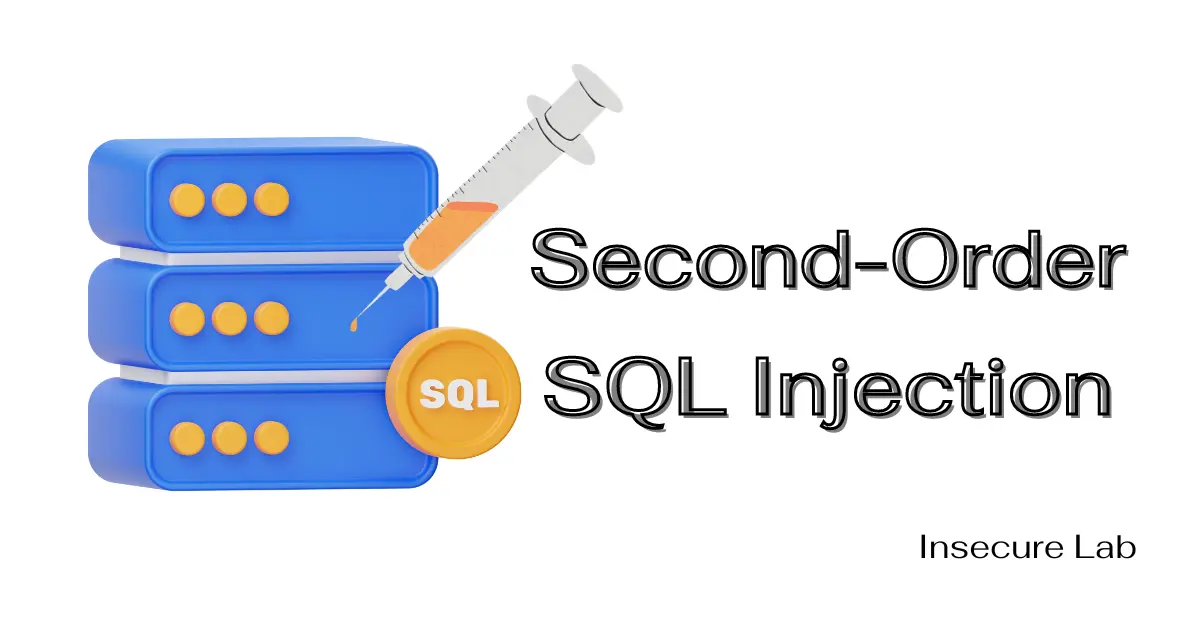Table of Contents
This ethical hacking guide explains Second Order SQL Injection with an example, the impact of this web vulnerability and its prevention in cyber security.
What is Second Order SQL Injection?
Second Order SQL Injection (also known as stored SQL injection) refers to a more complex form of SQL injection attack where the malicious SQL query is not directly executed at the initial point of the attack. Instead, the payload is stored within the database and triggered by a subsequent event or action.
This type of attack exploits vulnerabilities in the system’s logic to execute unintended SQL commands when data is later retrieved and used from the database.
Understanding SQL Injection
SQL injection (SQLi) is a common web application security vulnerability that occurs when an attacker can manipulate SQL queries made by an application. This manipulation may lead to unintended consequences, such as unauthorized access, data leakage, or data modification.
How Second-Order SQL Injection Works?
In a typical SQL injection, an attacker inputs malicious SQL code directly into a form or URL that affects the SQL query being processed by the application. In contrast, second order SQL injection involves two steps:
1. Injection Stage
The attacker injects the malicious SQL code into the application, but it is not executed immediately. Instead, it is stored in the database, often looking harmless and bypassing security checks.
2. Execution Stage
The application later retrieves the stored malicious code and executes it as part of a legitimate SQL query for another operation.
Differences from First-Order SQL Injection
1. Delayed Execution
Second Order SQL Injections do not manifest immediately but require a specific event or condition to trigger the execution of the malicious code.
2. Detection Difficulty
They are more challenging to detect because the data may appear non-malicious when initially stored.
Example of Second Order SQL Injection
To better understand second-order SQL injection, let’s walk through an example.
Consider a simple web application that allows users to submit reviews for products, and these reviews are stored in a database.
1. User A submits a review for a product with the following content:
"This product is great!"
2. The application stores this review in the database without proper input validation, resulting in the following SQL query being executed:
INSERT INTO product_reviews (user_id, review_content) VALUES (1, 'This product is great!');3. User B, who is an attacker, submits a review with malicious content:
"'; DELETE FROM product_reviews WHERE 1=1; --"
4. The application stores this malicious review in the database, executing the following SQL query:
INSERT INTO product_reviews (user_id, review_content) VALUES (2, ''; DELETE FROM product_reviews WHERE 1=1; --');5. Later, when an administrator views the list of reviews, the application retrieves the reviews from the database and displays them without proper validation:
SELECT * FROM product_reviews;6. The application generates the following output:
Review 1: This product is great!<br>Review 2: ''; DELETE FROM product_reviews WHERE 1=1; --7. The attacker’s malicious input is executed, resulting in the deletion of all product reviews:
DELETE FROM product_reviews WHERE 1=1;In this example, the attacker was able to inject malicious SQL code into the application by submitting a seemingly harmless review. The real damage occurred when the application later retrieved and displayed the stored reviews without proper input validation, leading to the unintended deletion of all product reviews.
Consequences
If attackers successfully exploit this type of SQLi vulnerability, it could have a serious impact on web applications:
1. Data Exfiltration
Attackers can retrieve sensitive data from the database, such as user credentials, personal information, or financial records.
2. Data Manipulation
Attackers can modify or delete data, potentially causing data loss or service disruption.
3. Authentication Bypass
Second-order SQL injection can be used to bypass authentication mechanisms, gaining unauthorized access to sensitive areas of an application.
4. Data Integrity Issues
Manipulated data can lead to integrity issues in the application’s database, making it unreliable.
Prevention and Mitigation
Preventing second-order SQL injection vulnerabilities in web applications requires a combination of secure coding practices and input validation. Some of the best mitigation strategies include:
1. Input Validation
Rigorously validate all inputs, even those retrieved from the database, before using them in SQL queries.
2. Prepared Statements
Use prepared statements with parameterized queries to separate SQL logic from data.
3. Stored Procedure
Use stored procedures that are predefined in the database. Although they are not inherently secure, if properly implemented they can be designed to execute specific SQL without allowing additional SQL injection.
4. Escaping User Input
Implement appropriate escaping mechanisms for special characters in user inputs.
5. Database Permissions
Apply the principle of least privilege by limiting database permissions.
6. Use ORM (Object-Relational Mapping) Tools
ORM tools can abstract database interactions and help in avoiding direct SQL query construction, thus reducing the risk of SQL Injection attacks.
Summary
The danger of second-order SQL injection lies in its subtlety and the fact that it can bypass many of the safeguards placed against regular SQL injection. It exploits the trust in data stored by the database system, assuming that the data already in the database is secure.
Therefore, understanding and preventing Second Order SQL Injection is important for any web application from a cybersecurity perspective.

